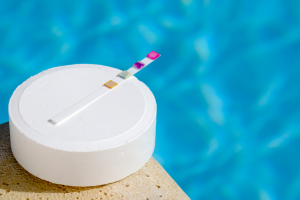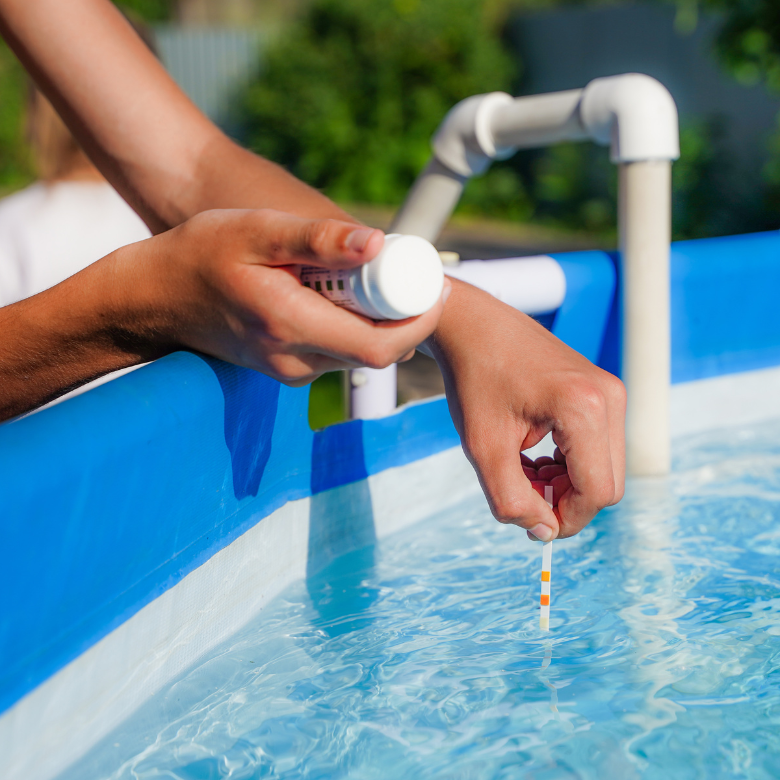The sector of swimming pool chemicals currently has a lot to offer to customers who like to take care of their backyard swimming pools. How to avoid unpleasant odours and the proliferation of fungi, bacteria and worms in the water? Simply perform shock chlorination. From this article, you will learn what shock chlorination is and how to perform it.

What is shock chlorination?
The occurrence of decomposition processes in water is something completely natural and unavoidable. Under the influence of high temperature, oxygen, sunlight and organic pollutants present in the water, various microorganisms develop. To inhibit that development, it is sufficient to carry out shock chlorination of water in your pool. What is it? It is a simple procedure that involves a one-off saturation of water with a large amount of chlorine.
The market offers a wide range of shock chlorination agents. These include chlorine dispensers in the form of granules, powders, tablets, and capsules. Microorganisms affected by a high chlorine concentration die quickly, and the water regains its aesthetic appearance and neutral smell.
When and why should we perform shock chlorination of a pool?
Are you wondering when the best time is to chlorinate your pool water? This procedure should be carried out as a routine, at least once a week or in the following cases:
- after each water change,
- after any extended swimming, especially if several or more people have been in the pool,
- when your tester (chlorometer) indicates that the chlorine level in the pool is too low,
- when you see that the water changes its colour or smell.
According to the recommendations of the manufacturers of pool chemicals and measuring equipment, the correct concentration of free chlorine in the water should range from 1 mg to 3 mg per 1 litre of water. Any deviations from these standards should be corrected on an ongoing basis by shock chlorination (when there is too little chlorine) or with the use of special chlorine neutralisers.
Maintaining the pool by shock chlorination is a simple and effective way to keep the water in good condition. Chlorine has a disinfecting effect, which allows you and your loved ones to swim safely. A sudden increase in chlorine concentration in the water immediately kills pathogenic microorganisms and algae. In addition, purified water looks fresh and attractive.

Pool shock chlorination: how to do it?
Every time you would like to perform shock chlorination with tablets or granules, you should read the manufacturer’s guidelines. Please note that the treatment should be done after swimming, when there is nobody in the pool. Also, pay attention to the recommended dosage. The proportions of chlorine vary depending on whether you are disinfecting your pool for the first time or it is a part of maintenance performed on a regular basis.
When and how to perform shock chlorination of water? It is best to do it in the evening, when the water temperature drops and there is no sunlight. Start by checking the water’s pH (optimum pH value is 7 to 7.4; if the tester indicates other values, use acidifying or alkalising preparations). Every chlorine-based product for shock disinfection should be used according to the instructions. Some granules can be directly poured into the water, along the edge of the pool. Other, powdered preparations need to be dissolved or placed in special dispensers before use.
Shock chlorination: how much chlorine should be added to the pool?
Each package of a shock chlorination product should include information about the dosage. The amount of the product should be selected based on such factors as:
- the size of the pool,
- water condition (cloudy and bad-smelling water requires higher doses of the disinfectant),
- chlorine level (if it is a continuation of shock treatment).
How much product is enough for effective shock chlorination? The average dose of chlorine per 10 m3 of water is 40 g to 150 g for granulates. For chlorine tablets or capsules, manufacturers usually recommend using 1 chlorine capsule per 1 m3 of pool water.
- https://dem.nv.gov/uploadedFiles/demnvgov/content/Resources/NVCoop%20Ext_Shock%20Chlorination_Step%20By%20Step%20Guide.pdf
- https://wellwater.oregonstate.edu/well-water/bacteria/shock-chlorination
- Webb, Scott (May 2011). "Is Superchlorinating The Best Way To Eliminate Chloramines?". AQUA Magazine. Retrieved September 3, 2017.
